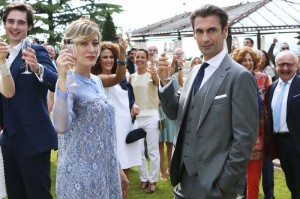This film is a hit in Italy, and early response is positive at the Tribeca Film Festival. The audience seemed enthusiastic, although there’s likely a buzz factor when the director and the two glamorous lead actresses show up.
The prologue shows a bicyclist struck by a car at night, with the car just driving off. We had already seen him as a waiter at a lavish banquet, and he was on his way home. We find out later he will die from his injuries. So it will be a hit-and-run case movie; it will be told in three parts, each named for a central character. The first part concerns Dino, a middle-aged neer-do-well who is married to, Roberta, a psychologist. This part opens six months before the accident, when Dino picks up his teenage daughter, Serena, at her boyfriend’s house. The boy, Massimiliano, is obnoxious and spoiled, especially by his mother, Carla, who’s somewhat of a ditz. The boy’s father, Giovanni, is a wealthy hedge fund owner. When he finds this out, Dino can’t pass up the chance, and he lies to Giovanni about his finances in order to buy into the fund. The second section concerns Carla, who spends her days shopping and regretting the theatrical career she abandoned to marry Giovanni. But her passion in life is her son, especially after the police suspect he is the driver of the car. The final section is about Serena, who had been a mere presence in the film until then. But there were hints earlier that she is hiding a secret about the accident, and we see the reasons for that. By the end of the film, the real driver of the car is sent to prison, but not because the police solve the case. Instead, we see that the cause of “justice” is only served because of a secret deal that saves Dino from financial ruin.
The director, Paolo Virzi, is clearly a talented filmmaker. Frame composition, editing, cinematography and pacing show control and assurance. The talented and attractive cast perform competently, creating sharply defined, if shallow, characters. The main problem I had was with the characters themselves. The first two sections, which are well over half the film’s length, are concerned with characters who are distasteful and/or stupid, and there’s little pleasure in watching them. They are familiar, shallow bourgeois types, presented without insight or humor. The two fathers, in particular, are so repellent that I was irritated by the women who married them, even though they are meant to be sympathetic. Much screen time is also spent on Carla’s affair with a theatre director. Besides having nothing to do with the main story, it includes one of the most pointless and unconvincing sex scenes I can remember. I should also mention that – even in subtitles – a lot of the dialogue rings false, as in bad soap opera. One of many examples is when a group of teenagers sees Serena with Luca, one whispers something like, “Look, there she is with the druggie.” The fact that the story was adapted from an American novel may also explain these awkward moments.
The film improves in the final section, when we are shown events from the daughter’s viewpoint. By the day of the accident, Serena has dumped the worthless Massimiliano and become involved with Luca, an emotionally fragile boy who had gone to prison to protect his uncle, who, incredibly enough, is an even more disgusting person than Dino and Giovanni. Luca is meant to be sympathetic, but is only a generic victim type, the kind you find on your average “Law and Order” episode. Serena, however, as played by the talented Matilde Gioli, in her debut performance, is the moral center of the film. She has inner strength and genuine compassion for others. The final shot is uplifting and hopeful, showing how Serena shrugs off the selfish behavior of the adults around her to help another human being in trouble.
The film is being touted as a hard-hitting probe of financial corruption, but it’s really not. You’ll find a slickly made human drama, intermittently affecting, but marred by phony touches and one-dimensional characters.


